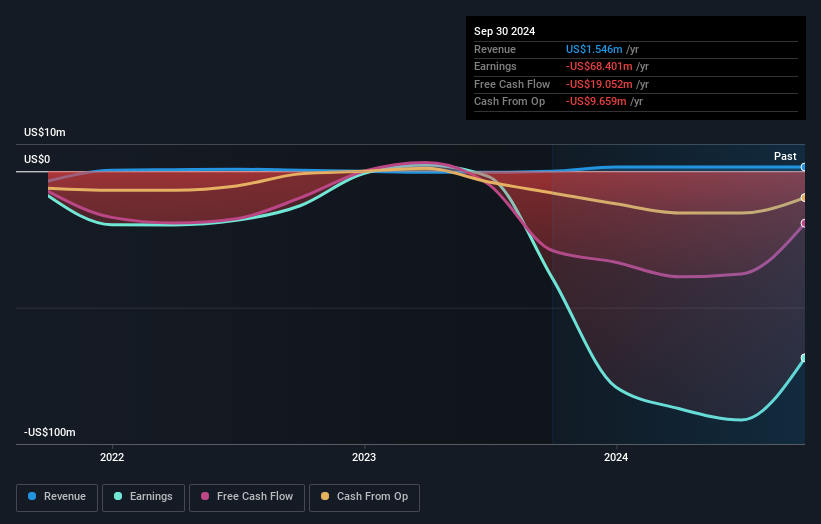- United States
- /
- Oil and Gas
- /
- NasdaqCM:PROP
Insiders are the top stockholders in Prairie Operating Co. (NASDAQ:PROP), and the recent 21% drop might have disappointed them

Key Insights
- Insiders appear to have a vested interest in Prairie Operating's growth, as seen by their sizeable ownership
- A total of 2 investors have a majority stake in the company with 54% ownership
- Institutional ownership in Prairie Operating is 16%
If you want to know who really controls Prairie Operating Co. (NASDAQ:PROP), then you'll have to look at the makeup of its share registry. The group holding the most number of shares in the company, around 60% to be precise, is individual insiders. Put another way, the group faces the maximum upside potential (or downside risk).
As market cap fell to US$149m last week, insiders would have faced the highest losses than any other shareholder groups of the company.
Let's take a closer look to see what the different types of shareholders can tell us about Prairie Operating.
Check out our latest analysis for Prairie Operating

What Does The Institutional Ownership Tell Us About Prairie Operating?
Many institutions measure their performance against an index that approximates the local market. So they usually pay more attention to companies that are included in major indices.
Prairie Operating already has institutions on the share registry. Indeed, they own a respectable stake in the company. This suggests some credibility amongst professional investors. But we can't rely on that fact alone since institutions make bad investments sometimes, just like everyone does. When multiple institutions own a stock, there's always a risk that they are in a 'crowded trade'. When such a trade goes wrong, multiple parties may compete to sell stock fast. This risk is higher in a company without a history of growth. You can see Prairie Operating's historic earnings and revenue below, but keep in mind there's always more to the story.

Our data indicates that hedge funds own 6.6% of Prairie Operating. That worth noting, since hedge funds are often quite active investors, who may try to influence management. Many want to see value creation (and a higher share price) in the short term or medium term. Gregory O'Neill is currently the largest shareholder, with 46% of shares outstanding. For context, the second largest shareholder holds about 8.0% of the shares outstanding, followed by an ownership of 6.6% by the third-largest shareholder. Furthermore, CEO Edward Kovalik is the owner of 5.0% of the company's shares.
A more detailed study of the shareholder registry showed us that 2 of the top shareholders have a considerable amount of ownership in the company, via their 54% stake.
While studying institutional ownership for a company can add value to your research, it is also a good practice to research analyst recommendations to get a deeper understand of a stock's expected performance. As far as we can tell there isn't analyst coverage of the company, so it is probably flying under the radar.
Insider Ownership Of Prairie Operating
The definition of company insiders can be subjective and does vary between jurisdictions. Our data reflects individual insiders, capturing board members at the very least. Management ultimately answers to the board. However, it is not uncommon for managers to be executive board members, especially if they are a founder or the CEO.
I generally consider insider ownership to be a good thing. However, on some occasions it makes it more difficult for other shareholders to hold the board accountable for decisions.
Our information suggests that insiders own more than half of Prairie Operating Co.. This gives them effective control of the company. So they have a US$89m stake in this US$149m business. Most would be pleased to see the board is investing alongside them. You may wish todiscover (for free) if they have been buying or selling.
General Public Ownership
The general public-- including retail investors -- own 12% stake in the company, and hence can't easily be ignored. While this size of ownership may not be enough to sway a policy decision in their favour, they can still make a collective impact on company policies.
Private Company Ownership
It seems that Private Companies own 6.3%, of the Prairie Operating stock. It might be worth looking deeper into this. If related parties, such as insiders, have an interest in one of these private companies, that should be disclosed in the annual report. Private companies may also have a strategic interest in the company.
Next Steps:
While it is well worth considering the different groups that own a company, there are other factors that are even more important. For instance, we've identified 3 warning signs for Prairie Operating (2 are a bit unpleasant) that you should be aware of.
If you would prefer check out another company -- one with potentially superior financials -- then do not miss this free list of interesting companies, backed by strong financial data.
NB: Figures in this article are calculated using data from the last twelve months, which refer to the 12-month period ending on the last date of the month the financial statement is dated. This may not be consistent with full year annual report figures.
New: Manage All Your Stock Portfolios in One Place
We've created the ultimate portfolio companion for stock investors, and it's free.
• Connect an unlimited number of Portfolios and see your total in one currency
• Be alerted to new Warning Signs or Risks via email or mobile
• Track the Fair Value of your stocks
Have feedback on this article? Concerned about the content? Get in touch with us directly. Alternatively, email editorial-team (at) simplywallst.com.
This article by Simply Wall St is general in nature. We provide commentary based on historical data and analyst forecasts only using an unbiased methodology and our articles are not intended to be financial advice. It does not constitute a recommendation to buy or sell any stock, and does not take account of your objectives, or your financial situation. We aim to bring you long-term focused analysis driven by fundamental data. Note that our analysis may not factor in the latest price-sensitive company announcements or qualitative material. Simply Wall St has no position in any stocks mentioned.
About NasdaqCM:PROP
Prairie Operating
An independent energy company, engages in the acquisition, development, and production of crude oil, natural gas, and natural gas liquids in the United States.
Mediocre balance sheet low.
Market Insights
Community Narratives


